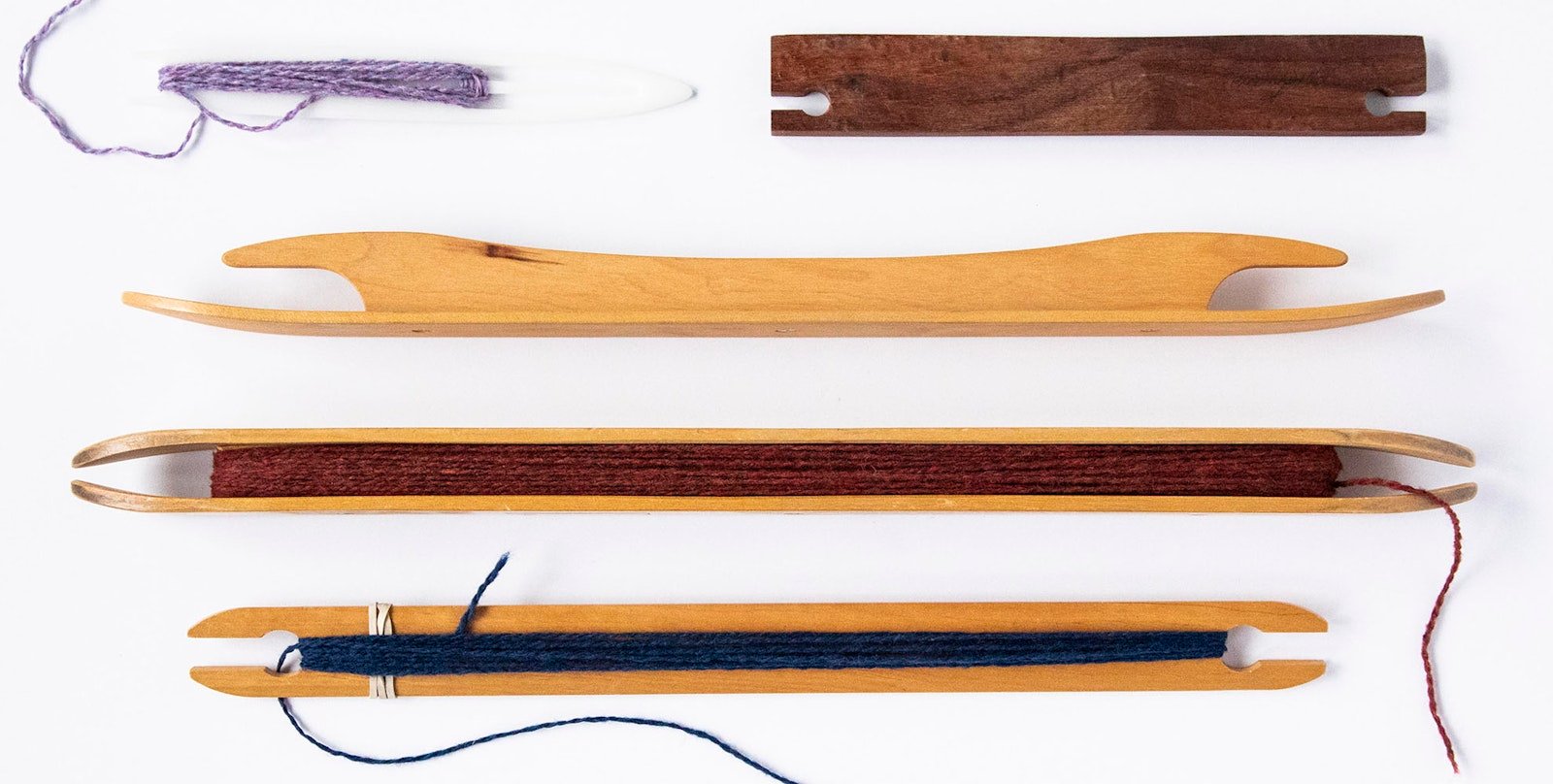Here is the second in our series by Liz Moncrief about the main types of weaving shuttles. —Susan
In this 4-part blog series, I’m reviewing weaving shuttles. In my first post, I talked about stick, belt, netting, and rag shuttles. Today, I’m covering rug and ski shuttles—shuttles that I use constantly. I’ll share the basics of the shuttles’ form and function and why they work well for their respective purposes, with tips for selecting the best shuttle for you.

A rug shuttle has curved tips on the top and bottom at both ends. This photo and the photos below by Liz Moncrief
RUG SHUTTLES are simple tools and are often confused with rag shuttles. As a weaver, you can use any shuttle for any purpose that works for you, but rug shuttles work well with heavier wool or cotton weft yarn in rug weaving. Rug shuttles feature a full “ski” on the top and bottom with a slight tip that turns inward at both ends. The tip prevents the shuttle from diving down through the warp. Rug shuttles are wound with the weft going around from front to back, and they can usually hold quite a lot of weft. Rug shuttles work well without the support of a shuttle race, which is found on jack looms. (We’ll talk about the shuttle race-way in a future blog). Rug shuttles are generally 16" and longer.
There are a couple of styles of the ski shuttle, my favorite type of shuttle, and I’ll talk about two here. Ski shuttles only have the ski on the bottom, and most have a typical ski tip on both ends.

In this type of ski shuttle, the middle section helps to hold up the upper ends of a narrow shed.
The SKI-TYPE SHUTTLE functions in the same manner as the rug shuttle as you wind your weft around the middle rib support. The shuttle has an arched set of wings that face downward to hold the weft in, and those wings also serve to hold up the upper ends of a shed if it is narrow.

A true ski shuttle can hold a lot of weft in the middle section.
Next is the true SKI SHUTTLE, where the middle section is simply the flat surface of the ski with no wing structure. On this shuttle, you wind your yarn in a figure eight and the bulk of the yarn, the cross, actually lies lower than the wings so your weft yarn doesn’t bulk up. These wings, which are curved downward at the front and back, will hold a very large amount of yarn.
It’s imperative that the bottom of your ski shuttle be absolutely smooth. If it isn’t, use very fine (000) steel wool to keep it smooth as glass, and apply a thin coat of paste wax after polishing. Follow the instructions that come with the wax and be sure to give the shuttle a glossy hand-rubbed finish. If you have done a good job rubbing the wax in, the shuttle’s smooth glide will be evident right away, and there won’t be any wax residue on your warp.
I’m not always careful inserting my shuttles, and at times the entry side of the shuttle will rub against the reed. You’ll see the results after several warps…the back side of the ski will eventually wear a bit in the finish, and this is another good reason to wax your shuttles. Shuttles are important tools in my weaving process, and I’ve always believed that anything made of wood deserves care.
If you are considering what size rug or ski shuttle is best for you, here is something you should think about: your personal arm span. For instance, my largest loom is 60" wide, and I can effectively weave a width of about 54". Since I prefer to sit on my bench while weaving, my reach is about 25" to either side and another 4" if I lean. And here is the dilemma. My favorite ski shuttles are 25" long. If I were to reach 25" to the right and try to insert a 25" ski shuttle, I would need to hold the shuttle in the middle of the near end in order to insert it into the shed. If you want to weave a very wide piece and want to sit, consider the length of your ski shuttle, the length of your arms, and whether you can make that stretch. Even though the longer shuttle may look attractive in terms of the amount of weft it can hold, it might be hard for you to use.
I have solved this problem for myself with the use of a treadle gate on my 60" loom. When I use the treadle gate, I weave standing up and walk back and forth. I gate the treadles to hold the sheds open while I am moving from side to side. You can see an example of that and more explanation of the process of using a treadle gate in Handwoven May/June 2019.
Other considerations are the look and feel of a shuttle. I love beautiful shuttles, so I used to buy my shuttles from a craftsman in Wyoming who made the most butter-soft skis out of gorgeous wood. I have a collection of them, but sadly, he is no longer making them. Perhaps a good woodworker out there feels a mission coming on? Rug and ski shuttles are lightweight, 110–170 grams (4–6 ounces), but holding them in your hand is the best way to know which ones are right for you.
That said, weight and balance of a shuttle can be very important. We’ll talk about those two factors in the next blog when we investigate boat shuttles, which tend to be heavier, sometimes for very important reasons.

